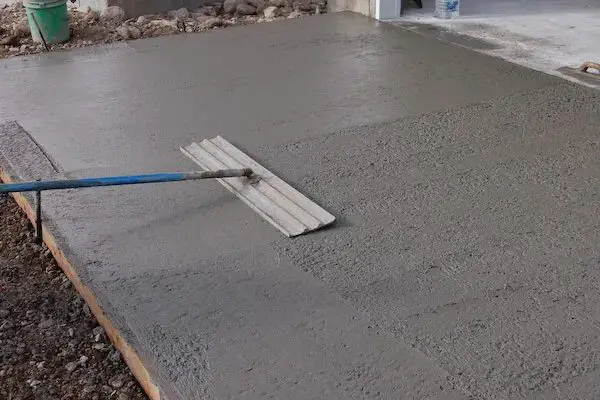Concrete bleeding is defined as free water in the mixture rising to the top of freshly poured concrete due to the settlement of heavier particles like cement and water.
The formation of a cement paste known as laitance.
As a result of the creation of laitance, freshly-poured concrete constructions lose their resistance capability, strength, and lifespan.
In this article you’ll learn:
So, if you’re ready to go with concrete bleeding, this article is for you.
Let’s dive right in.
What is Concrete Bleeding?
Early bleeding in concrete is associated with fully plastic that does not cause much harm.
The fully plastic will subside and compact but delayed bleeding happens when the concretes has lost its plasticity form.
Concrete bleeds as the free water in a plastic state rise to the surface as the coarse aggregate tries to settle down and segregates.
Purpose of Concrete Bleeding:
- Concrete bleeding took place as a type of segregation.
- The top surface of freshly mixed concrete is weaker by the presence of a thin layer of water; laitance eventually forms on this surface.
- It is seen when cement, aggregate, and water are mixed in an excessively wet and improperly balanced manner.
- They happen when evaporation and bleeding rates are equal.
- It occurs as a type of concrete in the so-called plastic state after placement and compacting of freshly mixed concrete.

Types of Concrete Bleeding:
In newly laid concretes, bleeding typically comes in a variety of forms as follows:
- Normal Bleeding.
- Channel Bleeding.
The process of uniform water seepage throughout the full surface of the structure is referred to as “normal bleeding.”
Water rises through a process known as channel bleeding that takes place in specific channels.
The bleed water won’t all make it to the concrete surface.
While some of them might ascend, others might get buried by the aggregates and the reinforcing.
The link between the plaster and constituents may become weaker.
Methods to reduce the Concrete Bleeding:
- To prevent bleeding leading to a weak structure and a delay in the construction process, proper precautions should be taken during the production of the mix and the manner of mixing.
- Increase the concrete mix’s water content to a minimum and utilize chemical admixtures to lessen the need for water to achieve the desired workability.
- Properly plan the concrete mix.
- Utilize fly ash or additional cementitious ingredients.
- Air entraining admixtures work incredibly well to stop the bleeding.
- Add additional cement to the mixture.
- If the sand is coarser, add more fine aggregate (a fineness modulus of 2.5 to 2.8 is ideal) and less aggregate in proportion.
Effects of Bleeding in Concrete:
- Concrete bleeding is regarded as damaging to civil engineering structures made of concrete and significantly reduces the strength of concrete structures.
- The water-to-cement ratio can lead to severe bleeding and is the key factor in bleed water rates.
- It eventually resulted in laitance on the top surface.
- There is also evidence of internal haemorrhage.
- It creates pores in the concrete.
- The uniformity of concrete is lost.
- There is a weak bond formation between the reinforcement and concrete’s component parts.
- Concrete loses strength and resistance.
- Delays in the surface finishing and curing of the job because water is forming at the top surface.
- Excessive bleeding and water build-up cause the link between cement paste and aggregate to weaken and the bond between concretes and reinforcement to break.
- It is the reason why concrete becomes permeable.
- Concrete’s capacity to be pumped has an impact.
- Increased bleeding on the concrete’s surface will have a significant impact on the water-to-cement ratio at the top surface.
- Sand with insufficient fines also tends to make concretes more prone to bleeding.
Disadvantages of Bleeding in Concrete:
- The bleeding channels will continue to flow if the used water-cement ratio is higher (0.7).
- A plane of weakness and a poor link between two layers of concrete result in the formation of laitance in a single concrete pour.
- Due to bleeding, concretes lack homogeneity.
- Concrete’s strength and resistance are reduced.
- Due to bleeding, the top surface of the slab and pavement will not have suitable bearing resistance.
- It reduces a concrete pump’s capacity to pump.
- Bleeding water surfaces causes delays in the application of curing and finishing touches.
Causes of Concrete Bleeding:
- Bleeding in concrete is caused by segregation (separation of the concrete’s constituent materials in the form of coarse aggregate separation, paste separation, and water separation out) in the concrete mix.
- Is a type of plastic state in which heavy aggregate particles settle down as a result of the settling of particles.
- The water rises to the top of freshly concreted surfaces as a result of water evaporation, and surface laitance is formed.
- It occurs more frequently on the top surfaces of freshly concrete construction which has a significant impact on the strength and durability of the concrete.
- Other factors such as the type of cement used, the number of fine aggregates, and the wrong proportion of concretes elements play a role in the causes.
Also read: Concrete Laitance | Concrete Topping | Concrete Screed | Concrete Spalling
Conclusion:
Concrete bleeding occurs when free water from the mix rises to the surface that produces a cement paste known as “laitance” on the surface.
A form of segregation occurs when water leaks through concrete.


Related Posts
Refresh Your Office: Simple Ideas to Boost Productivity and Motivation in Your Workplace:
Understanding the Nuances of Office Chair Vs Ergonomic Chair to Select Better!
Rock Quality Designation(RQD): Building Strong Foundations
Spread Footing
Masonry Cement
Plain Cement Concrete
Concrete Efflorescence
Concrete Pile
Stepped Footing